15 Creatures You Never Knew Were Parasites
Parasites are vile creatures who feed off the lives and blood of others. The
initial myths and lore surrounding vampires drew off the general fears and
perceptions of parasites. Even today, they are not well received, and why should
they be. Parasites can kill their hosts, and they rarely ever leave them better
off than when they first arrived. The most horrifying part of their conduct is
that they can sometimes kill their hosts before the hosts even realize the
parasite was there.
Ancylostoma caninum - Type of Hookworm Attached to Intestinal Mucosa

The fact is, though, that parasites are everywhere. It's an
effective means of survival, and there are many that you never even knew existed
or that were actually parasites, especially these 15 parasites here.
15) Vampire Bats
Speaking of vampires, the vampire bat is a creature that most
people don't realize is a parasite. A common misconception about parasites is
that they must be attached and immobile on the host. While some scientists
insist that only true parasites can be defined as those that live on the host,
others, such as the authors of "Vampire Bats Among Us" state that the vampire
bat demonstrates all of the necessary indicators needed to be a parasite with
that exception.
Vampire Bat of South America
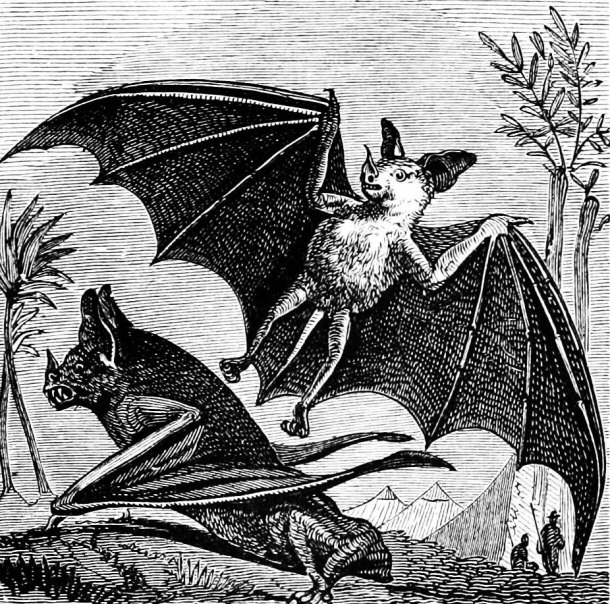
Given that they also transmit some of the same bacteria and
viruses that a regular parasite does and that they often return to the same
victim, the vampire bat is at least dangerous enough to be a pseudo parasite.
Vampire Bat Drinking Blood
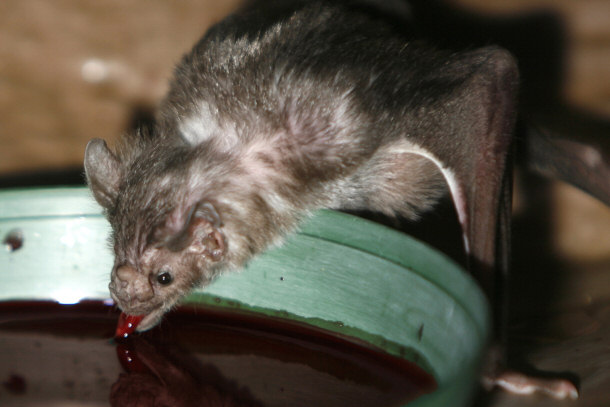
Generally speaking, though, it does not like people as much as it likes
horses and cows. Unlike its Transylvanian vampire cousins, the vampire bat
prefers to feed near the hooves of its victims rather than the neck. It bites
into the victim and begins to lap the blood up. In some cases, it will bite
people. According to National Geographic, it has been documented as returning to
its victims. A series of vampire bats can actually kill a single animal if they
all try to feed.
14) Candiru Fish
The candiru fish is a small fish that lives in the Amazon. In
fact, it was recently the subject of numerous conservation efforts in Brazil.
The surprising discovery after the conservation efforts succeeded, though, was
that the Candiru Fish was actually the dreaded vampire fish. Yes, vampires
again.
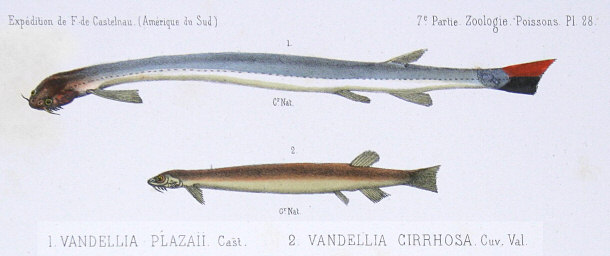
The candiru fish is a tiny fish. It rarely exceeds a few inches, but it loves
human urine. According to National Geographic, this tiny fish uses the scents
and tastes of urea and ammonia to track its prey. It then follows it. If the
prey turns out to be a fish, then the candiru forces its way into the gills. It
then shoots its spines into the gills and severs the primary blood vessel. From
there, it drinks straight from the major artery until the fish dies and the
candiru fish forces its way out of the rotting flesh to find another host.
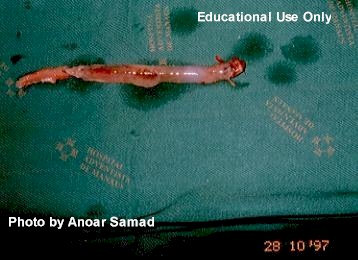
What makes the candiru fish so horrifying, however, is that, according to
"Horrifying Creatures," the candiru fish actually prefers human urine. If it
smells the urine, it tracks it down. From there, it will then leap to the
source. This is how it got its other nickname, according to Cracked.com: the
penis fish. It can jump high enough to enter the penis. From there, it shoots
out its spines and begins forcing its way up the penis.
X-Ray of Patient with a Candiru Fish Inside of His Penis
and Pelvic Region

The fish will remain in
the penis until it dies or until the host dies. The only way to remove it is
through surgery. In most cases, successful removal can only be accomplished by
removing the part of the penis in which the fish resides.
13) Stone Fish
National Geographic performed an in-depth spread on the stone
fish. It is one of Australia's more unusual fishes, living along the Great
Barrier Reef. The stonefish prefers to live at the bottom of the reef, and it
does not give any indications of its presence. It can function as both a
parasite and as a natural predator. According to "The World's Strangest
Creatures," the stonefish actually does not hunt its food. It just lays still
and allows shrimp and small fish to wander in. Then it sucks them down. When a
human or a large fish comes by, the scenario is quite different.
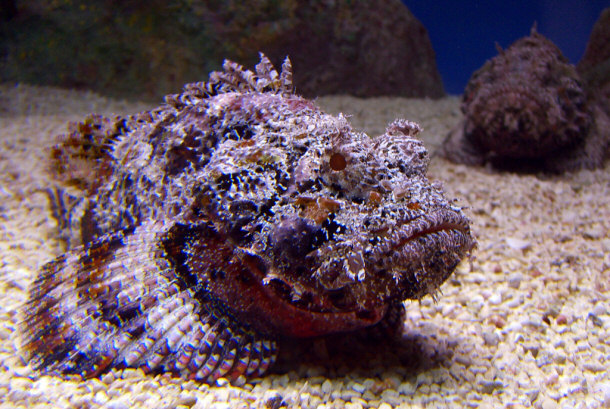
However, the stonefish has another method of getting food. If anything comes
too close, it shoots up 13 venomous spines. If it shoots them up properly, it
remains attached to the host for an extended period of time or until death. Most
people cannot survive if they do not receive treatment within two hours and if
they do not get the stonefish removed and assistance. The spines simultaneously
shoot in poison while the stonefish feeds. In most cases, human victims are able
to lurch free, but this does not mean that they are not out of danger.
Stone Fish on Display at Mote Marine Laboratory
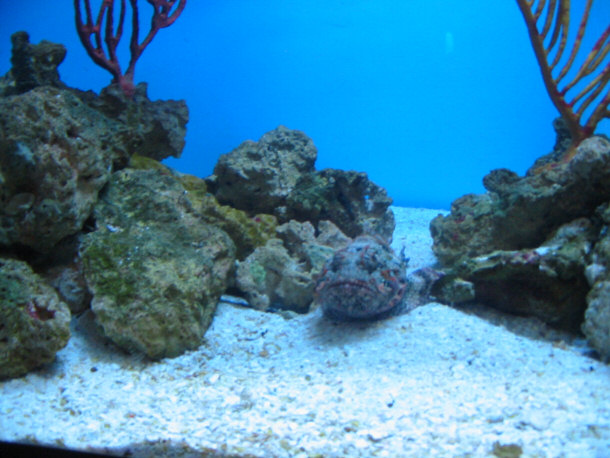
By Will Pittenger
via Wikimedia Commons
The pain
itself continues on, and death can occur within a short period, preceded by
nausea, seizures, paralysis, and more. Since its primary location is in the
shallow warm waters of the beaches and at the bottom of the Great Barrier Reef,
it is a pretty big threat for many swimmers. If you step on one, seek medical
attention immediately.
12) Guinea Worm
Guinea worms love humans. In fact, they love them so much that
they prefer humans to any other kind of prey. The problem is the effect that
they have on humans. The guinea worm starts its life cycle as a very tiny larva.
It is actually small enough that it can live on the water flea. In fact, that's
how it gets its start. It feeds off another parasite. What generally happens is
that the water flea gets swallowed by a host. The water flea is digested, but
the guinea worm can withstand the acidic conditions of the human stomach. In
fact, it thrives in them.
Guinea Worms can Spread Throughout the Body Often Infecting the Feet

The guinea worm begins to burrow through the stomach. It's hard to say where
it will end up according to "The Survival Guide." What does happen, though, is
that it starts to grow. It's overall a very unpleasant experience. It continues
to grow throughout its entire lifespan. Some of the longest have been longer
than the host is tall. Most of the time, though, they stop at about two or three
feet. According to National Geographic, the guinea worm is one of the few
parasites that come with a readymade escape technique when targeting human prey.
It burrows down to the foot or to the surface of the skin at some point.
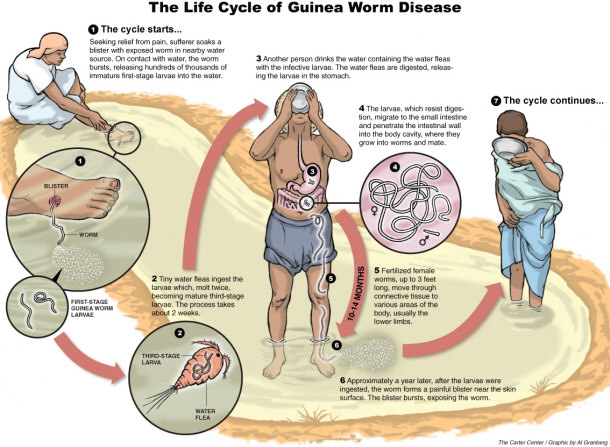
Then it
wraps its body around and starts to form an abscess. This abscess begins
burning. The common response is to plunge the burning area into fire. At that
point, the guinea worm ruptures through the host and releases its spawn out into
the water. There they latch onto water fleas. The guinea worm generally dies
shortly after this, though, they may try to escape.
11) Lonomia Caterpillar
The Lonomia Caterpillar lives throughout South
America, and it has gained a reputation as one of the scourges in Latin America,
according to Reuters. Unlike most caterpillars, this particular one doesn't care
how it gets its food. It will gladly eat whatever it finds, and it will also
latch on and pump out poison while absorbing its prey.
Taturana (Lonomia oblliqua) - Venomous Variety of the
Lonomia Caterpillar Family
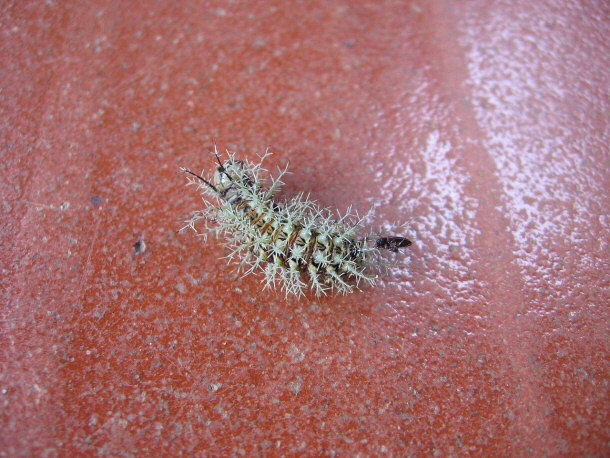
According to National Geographic, the biggest problem with the Lonomia
Caterpillar is what the venom does. The venom creates burns throughout the body.
It also starts headaches as well as nausea, but the biggest problem is that the
venom creates internal hemorrhaging. More advanced stages include hematuria and
ecchymosis. This means that you will start bleeding in your urine and bleeding
beneath your skin. At the same time, the venom prevents the blood from clotting,
and it eventually moves on to attack and shut down the kidneys.
Strategy Used in Exploring Lonomia obliqua Venom Based on
Cellular Approach
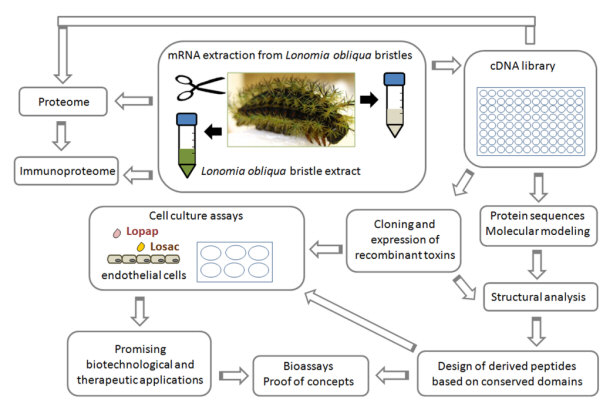
What makes this
even worse is that this beautiful little caterpillar does not even have to come
in contact with you. When it feels threatened, it starts launching spines. A
single spine that breaks the skin can cause these problems. The blood loss and
pain is truly horrific, and some are calling it the Caterpillar Scourge.
10) Tongue Crab
The tongue crab is similar to the tongue eating sea louse.
This strange parasite
prefers tongues to just about anything else. It starts off by finding a fish
that it likes. Red snappers are among the preferred choices. It forces its way
in through the gills, and then it latches on to the main arteries of the tongue.
As the crustacean grows, it consumes more and more blood. At the same time, the
fish's tongue continues to atrophy.
Tongue Crab and its Current Host
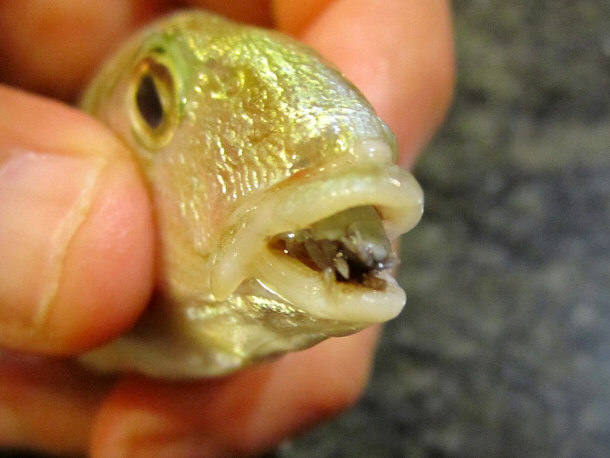
By Marco Vinci
via Wikimedia Commons
This results in the tongue eventually
falling off. As soon as this happens, the tongue crab attaches its body to the
tongue muscles of the snapper. The snapper uses the tongue crab like a regular
tongue, and the two continue on together for the rest of their lives.
Close-up of the Tongue Crab
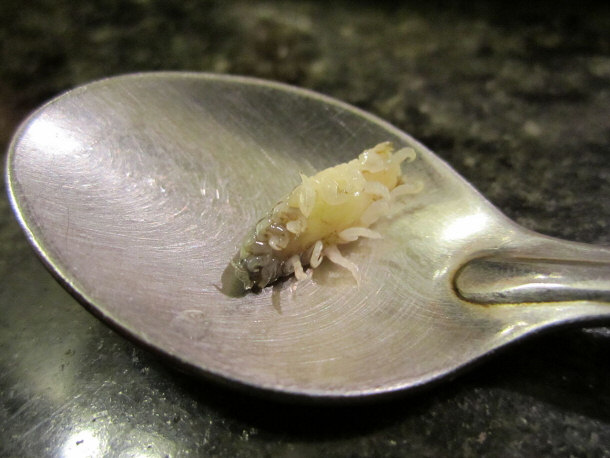
By Marco Vinci
via Wikimedia Commons
The tongue crab is considered one of the more horrifying parasites because it
gives no indication of its presence. Apparently, this process does not trigger
responses from the pain receptors. Additionally, the creature has started to
spread. According to the Tree Hugger, a newspaper, occurrences have increased
and spread, and there have been sightings even on the shores of New Jersey.
9) Australian Paralysis Tick
Everyone knows that creatures with red eyes
should be avoided at all costs. The Australian paralysis tick is one such
example. This tiny parasite is quite abundant in the Australian underbrush. The
problem that comes from this is that it paralyzes its victims so that it can eat
them in peace. The even bigger problem is that it prefers humans whenever it can
get them.
Australian Paralysis Tick Before and After Feeding
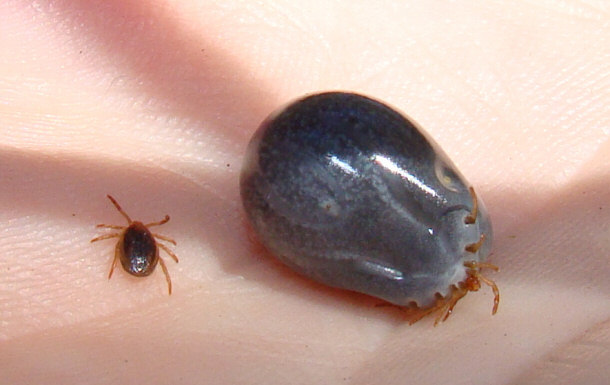
By Bjorn Christian Torrissen
via Wikimedia Commons
Scientists still don't know why paralysis is used. After all, no tick could
really consume all of the blood in a dog or a human. In fact, paralyzing the
victim would seem to result in a lesser level of food. After all, the host will
eventually die. This doesn't keep the Australian paralysis tick from doing so
anyway. The one spot of good news is that only the female can administer the
poison.
Adult Female Paralysis Tick
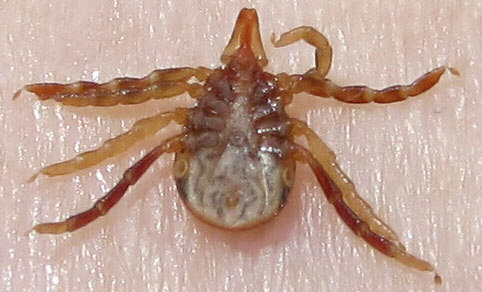
By Norbert Fischer
via Wikimedia Commons
It does this through what is known as a barbed hypostome. This basically
looks like a multi-pronged serrated blade. Medical treatment is essential. If
you can find one before paralysis, then you should get to a doctor immediately.
The venom takes awhile to paralyze the victim, and you will have the best chance
of rehabilitation if you get to the doctor.
8) Suicide Worm
The suicide worm is one of the stranger parasites. It looks
like a small earthworm. Nothing strange about it so far. It's actual name is the
horsehair worm, but the surprising fact about it is that it prefers
grasshoppers. Its favorite thing to do with grasshoppers is to make them commit
suicide. The horsehair worm attacks anything it can, but it is the most
effective on grasshoppers. The suicide worm
lays its eggs in the water. The grasshopper then drinks the water and consumes
the eggs. The eggs hatch inside the grasshopper's stomach. The worm itself
consumes all of its siblings. From there, it grows.
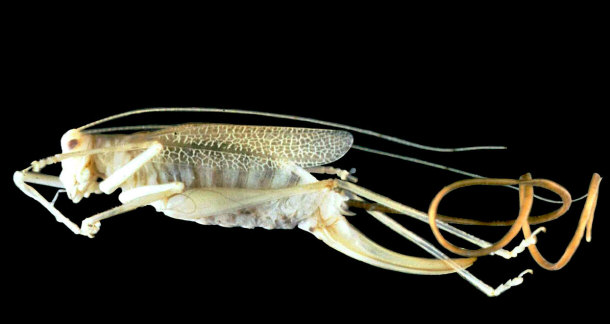
By Dbenzhuser
via Wikimedia Commons
The suicide worm becomes significantly larger. In fact, it can fill the
entire stomach of the grasshopper. The grasshopper would eventually die anyway because of malnutrition,
but before this can ever happen, the suicide worm starts releasing chemicals
that force the grasshopper to become suicidal. The primary impulse is that the
suicide worm forces the grasshopper into the nearest body of water. Once in the
water, the suicide worm ruptures through the grasshopper's body, generally
through the anus. Then it finds a mate and prepares for a family.
7) The Naegleria Fowleri
The Naegleria Fowleri is a amoebal parasite. In
fact, it is one of the smallest in the world, but it is also one of the
deadliest. It too prefers humans whenever it can get them. It is found in many bodies of water, including swimming
pools. No one is quite sure where they come from. What they do know is that they
are brain eaters who prefer teenagers.
Life Cycle of Parasitic Agents Responsible for Causing
"free-living" Amebic Infections
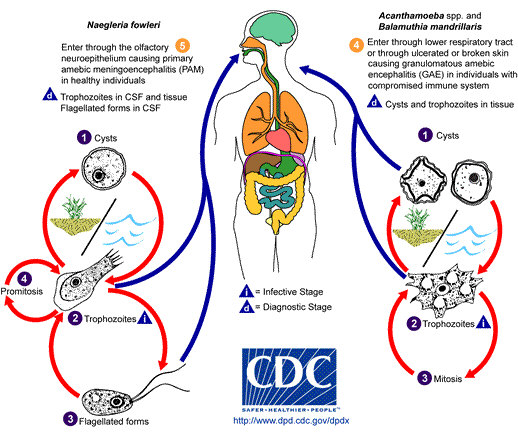
These brain eating parasites swim through the water and wait at the bottom of
the source. Once something splashes in, it tries to get up to the victim's nose.
For whatever reason, the parasite prefers teenagers, according to CBS. It only
takes one to start an infection. The amoeba works its way into the brain. Then
it begins eating the brain. Death generally results within two weeks. The only
symptoms are headaches and fevers.
Naegleria fowleri Lifecycle Stages
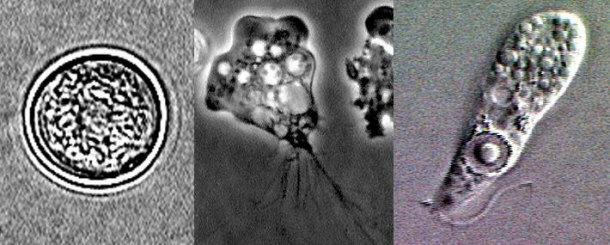
Hallucinations follow, but it is generally an
indication of advanced stages and imminent death. Successful treatment requires
an actual diagnosis, but, according to "Medical Mysteries," doctors aren't even
sure whether their treatment methods would work. Most of the time, the naegleria
fowleri is only discovered after an autopsy.

6) Filarial Worm
The Elephant Man was once thought to be a fictional
character. History and research has shown that it was actually a disease that
gave the Elephant Man his distinctive appearance. That disease and the effects
of the filarial worm are one and the same. The filarial worm is the bringer of
elephantiasis.
Elephantiasis

The filarial worm lives off mosquitoes. They actually live in the venom sacs
that the mosquito uses when it bites victims and pumps in its venom. While
waiting, it lives off the mosquito. The mosquito then
becomes the inadvertent injector of the filarial worm. The filarial worm thrives
in all creatures that the mosquito's bite can penetrate. It begins to work its
way through the body as it matures until it reaches the lymphatic system.
From
there, it releases its own eggs and then the
horror begins to happen. All of the little worms break out of their eggs and
begin to work their way through the lymphatic system and lymph nodes.
Eventually, it blocks them entirely.
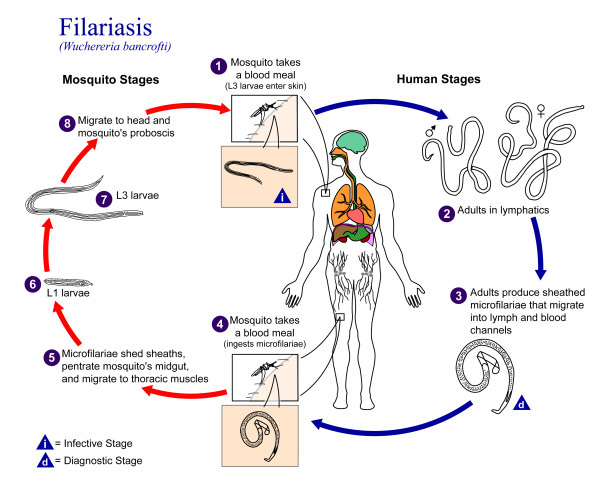
Once the lymph nodes are blocked, all of the body's vessels begin to enflame.
The obstruction can continue until the body literally explodes, but more
importantly, it causes grotesque and massive swellings. The swelling primarily
affects the genitals and the legs. This is both excruciating and debilitating.
Treatment requires extensive and vigorous cleansing to fully remove the worms.
According to the Lymphatic Filarisis Elimination Program, eradication may
require surgical treatment, but the best way to treat it is through a
vaccination that is currently in development.
5) Sacculina
The sacculina is actually a strange barnacle that is also a
parasite. Barnacles are typically those things that you see hanging on the
undersides of boats. The female sacculina is not so innocuous. It actually waits
until a male crab comes by and then it attacks. However, this particular
parasite wants sex and dinner.
Sacculina Barnacle (Highlighted) on a Female Swimming Crab
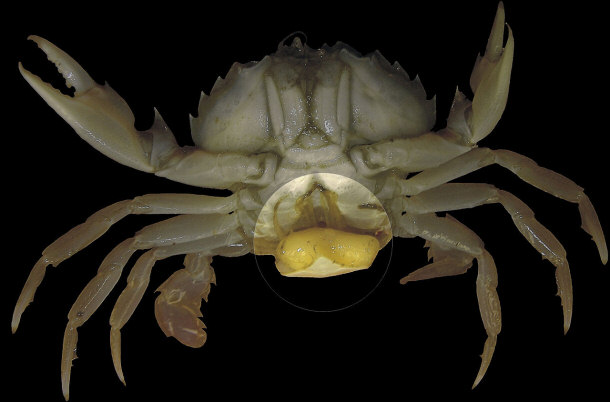
By Hans Hillewaert
via Wikimedia Commons
The first thing that the female sacculina does is feed off the crab until she
gets her strength up. Then she forces herself into the male crab. From there,
she sterilizes him and cuts off his genitals. After that, she forces hormonal
changes through her bites as she continues to feed on him. These hormonal
changes make the crab appear to be female. The male sacculina follows a similar
pattern except that it does not strip off the male crab's genitals. It sets up
its location on the genitals and waits to see a male crab that houses a female
sacculina. While the two crabs mate, the sacculinas do their business, and then
release the eggs into the ocean. This is one of the stranger parasitic
behaviors, according to National Geographic, but it is highly effective.
Sacculina and Young
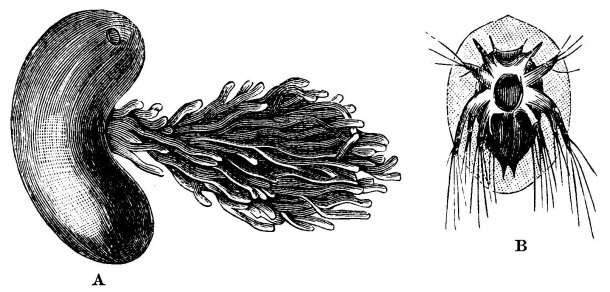
Researchers at the Oceanography Institute of Florida have been able to document
the migratory patterns of the barnacles, and they estimate that approximately 4%
of crabs have sacculinas.
4) Snail Eye Worm
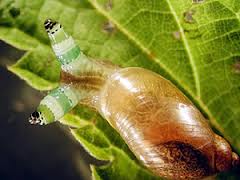 The
snail eye worm fortunately does not want humans. Its actual preference is birds.
The problem is that generally starts out in piles of
feces. It waits there until a snail comes and eats it. However, the snail eye
worm can survive the snail's digestive system. It goes up into the snail's
eyestalks, and from there, it changes the eyestalks' appearances. Generally, it
changes them so that they look like two caterpillars waving. This makes the
snail more appealing to birds. It does this by creating inflammation and
swelling so that the snail cannot retract its eyestalks. Most of the time,
according to National Geographic, snails keep their eyestalks heavily guarded
and tight inside. By the time that the snail eye worm is done, the snail cannot
retract both of its eyestalks. In most cases, according to "Bizarre Parasites,"
the snail eye worm inhabits one of the eyestalks, allowing the snail eye worm to
hide at least one. The
snail eye worm fortunately does not want humans. Its actual preference is birds.
The problem is that generally starts out in piles of
feces. It waits there until a snail comes and eats it. However, the snail eye
worm can survive the snail's digestive system. It goes up into the snail's
eyestalks, and from there, it changes the eyestalks' appearances. Generally, it
changes them so that they look like two caterpillars waving. This makes the
snail more appealing to birds. It does this by creating inflammation and
swelling so that the snail cannot retract its eyestalks. Most of the time,
according to National Geographic, snails keep their eyestalks heavily guarded
and tight inside. By the time that the snail eye worm is done, the snail cannot
retract both of its eyestalks. In most cases, according to "Bizarre Parasites,"
the snail eye worm inhabits one of the eyestalks, allowing the snail eye worm to
hide at least one.
A bird eventually spots the eyestalk that looks like a caterpillar, and it
snatches it up. The snail eye worm is then ingested, but it survives this
consumption as well. Eventually it meets up with another snail eye worm that is
also inside the bird, and they both continue to eat the bird's internal organs
and feed off the blood. The eggs are laid in the bird's digestive track so that
the bird releases them. The snail eye worms, however, continue to feed. In some
cases, when there are enough of them, they ultimately kill the host bird and die
along with it.
3) Emerald
Jewel Wasp
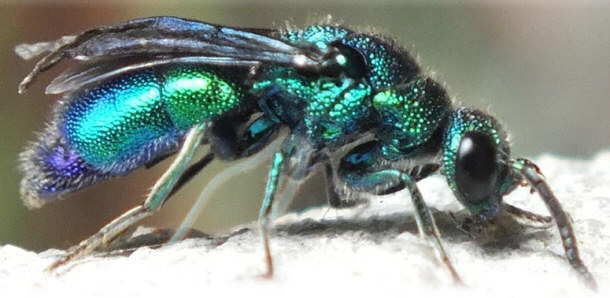
The emerald jewel wasp is actually considered one of
the most beautiful wasps in the world. It is also one of the most evil wasps.
It's also a devoted mother. When it's time for the female emerald jewel wasp to lay her
eggs, she digs a hole. She then goes out and finds a cockroach. According to
National Geographic, the cockroach has two to three times the strength of the
wasp, but the wasp does not let this bother her. She swoops down on the
cockroach and stings him with her long stinger. This both paralyzes and
anesthetizes the cockroach. After this, she injects her second stinger into a
specific part of the cockroach's brain. The venom then goes on to target the
survival instincts in the roach. This, ultimately, turns the cockroach into a
zombie roach.
Zombie Roach:
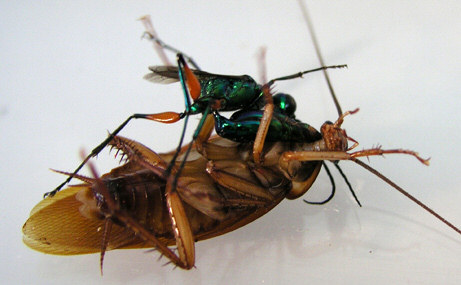
The wasp leads the cockroach back into the burrow. She lays her eggs on top
of its stomach. Then she bites off the antenna and feeds until she is content.
From there, she seals the burrow with rocks and leaves. The eggs eventually
hatch, and the baby emerald jewel wasps emerge. They dig down into the cockroach
and consume it alive. They also eat one another until only one is left. The baby
emerald wasp lives off its host until it is an adult.
2) Parasite Wasp
The parasite wasp takes on a decidedly different approach
to life as a parasite. It starts off as an egg and a larvae inside a
caterpillar. While inside, it does the typical parasitic thing by nourishing
itself on the caterpillar. However, it manages to leave the caterpillar's body
without harming it. The shocking part is what
comes next.
Parasitic Wasp Eggs (White Mass) Intertwined with Lime
Butterfly Caterpillar
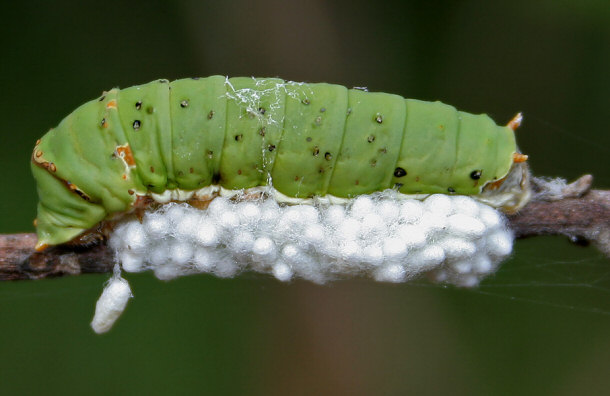
By J.M. Garg
via Wikimedia Commons
Once the wasp larvae emerges, the caterpillar suddenly becomes the wasp
larvae's protector. It refuses all food and it protects the wasps. It even goes
so far as to wrap them in protective silk. When predators arrive, it attacks,
using head butts and head swings to defend itself. The wasps eventually emerge
from their cocoons, but once more, they do not eat the caterpillar. The
caterpillar dies shortly afterward, and the wasp flies away. Scientists are
still uncertain what creates the mind change.
Wasp Parasitizing a Gypsy Moth Caterpillar
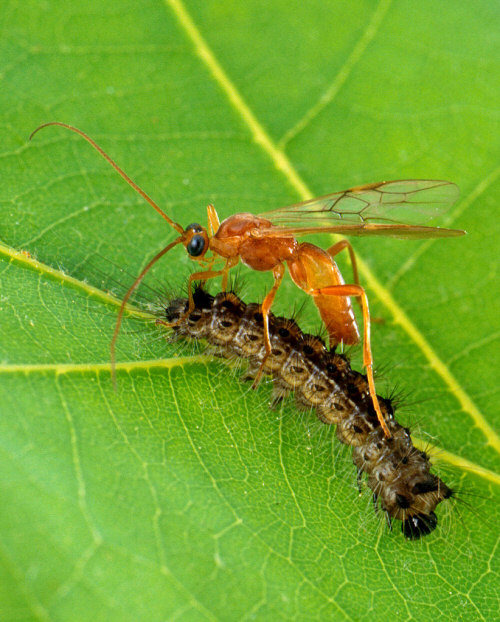
Research has been released in the PLoS One Journal, and speculation continues as to whether it is a hormonal
change or something similar.
1) Immortal Jellyfish
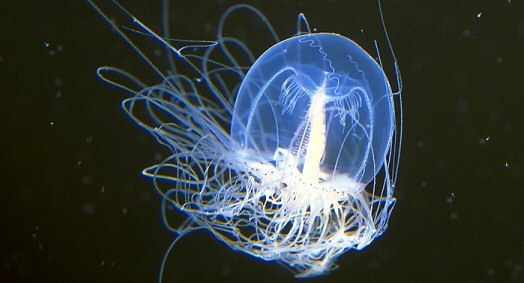
The immortal jellyfish's real name is turritopsis
dohrnii. It follows a process of trans-differentiation. Unlike most creatures
that reach old age and die, the immortal jellyfish just reverts back to its
childlike state. At the start of its life, it finds a host and attaches itself.
There it feeds and grows. From there, it then releases itself from the host and
goes on its way to mate and lay eggs. Once this happens, it transforms itself
into a tiny polyp, reabsorbs its own sex organs and tentacles. Then it attaches
itself to something so that it can continue. However, they are not actually so problematic. Many
of them are devoured or die from disease. While they do not attach humans, they
are pretty diverse. According to "Cheating Death," they can even attach
themselves to non biological material such as substrate. They can live for
extended periods off their own tentacles and organs by converting them into gel
within the hood. This process is quite bizarre, but it is one that many
scientists are trying to understand. Scientists originally hoped that there
would be a way to turn this into immortality for humans, but "Cheating Death"
states that scientists now agree that that is not likely to be the case.
Nature
Top Lists:
15 Fascinating Facts about the Amazon Rainforest
15 Remarkable Facts About Bacteria
15 Remarkable Facts About Jellyfish
15 Little Known Facts About Elephants
15 Fascinating Facts about Earthquakes
15 Odd And Interesting Facts about Monkeys
Top 15 Myths about Snakes
Top 15 Myths about Horses
Top 15 Creepy Deep Sea Creatures
15 Unexpected Animals That Can Kill You Quickly
Top 15 Spider Myths
15 Beautiful Animals that are Now Extinct
Top 15 Most Amazing Snakes Around the World
15 Fascinating Facts about Snow
Top 15 of the World's Rarest Flowers
10 Most Emotional Animals
15 of the Most Venomous Creatures to Roam the Earth
15 Unusual Animal Defense Mechanisms
15 Unusual and Less Known Uses of Rocks
15 Unique Forest Creatures Less Known To Man
15 Interesting Facts About Time
15 Unknown Parasites You Never Knew Existed
15 Weird Trees Around The World
15 Wild Animals Deadly to Humans
15 Exotic Insects That Are Harmful & Deadly
15 Ridiculous Uses for Gold
Informational:
Preparing for a Disaster
Proof That We Are What We Are!
What is the Meaning of Life?
The Trend and Challenges Facing the Urban World
Creation Narratives and the Evolution Creationist Debate |